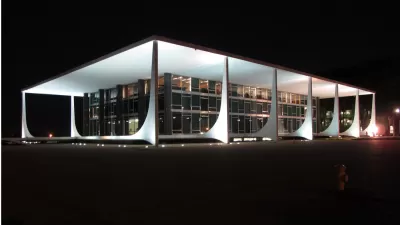Utopian modernism turned on its head in Caracas, where residents have made fifty-year-old superblock housing projects into the locus of sprawling improvised settlements.
[...] In the city's San Francisco Valley, these slums, where nearly half of Caraqueños live, dramatically run up against a series of gargantuan buildings with punchy red, yellow, blue, and white facades cut out from the hillside-superbloques. Each of these housing projects is forty meters tall and over eighty meters long. Nearly swallowed by ranchos, they are vestiges of modernist urbanism long since colonized by the realities of twentieth-century Caracas.
The last Venezuelan dictator, General Marcos Pérez Jiménez, oversaw the construction of the superblocks. The project was the concrete centerpiece of the New National Ideal, an ambitious renewal program intended to foment "the rational transformation of the physical environment." In the capital, this entailed a massive endeavor to rid the city of its metastasizing slums. Between Pérez Jiménez's fraudulent election in 1952 and downfall in 1958, the state built 28,763 housing units, many of them contained in Caracas' eighty-seven superblocks. The jewel was 23 de Enero, host to thirty-eight of them. Inaugurated in 1955 with the moniker 2 de Diciembre, in celebration of the dictator's assumption of power, the parroquia was rechristened 23 de Enero in 1958, to commemorate his flight from the country. It now stands as an ironic monument to the dictator and a continuing refutation of his legacy.
This admixture of Latin America's two most prevalent forms of shelter, modernist housing blocks and improvised slum dwellings, is not unique, but the scale, site, history, and density of 23 de Enero-over eighty thousand residents live in the parroquia's superblocks and ranchos-make it exceptional. [...]
Thanks to Matt Sledge
FULL STORY: The City that Built Itself

Study: Maui’s Plan to Convert Vacation Rentals to Long-Term Housing Could Cause Nearly $1 Billion Economic Loss
The plan would reduce visitor accommodation by 25,% resulting in 1,900 jobs lost.

North Texas Transit Leaders Tout Benefits of TOD for Growing Region
At a summit focused on transit-oriented development, policymakers discussed how North Texas’ expanded light rail system can serve as a tool for economic growth.

Why Should We Subsidize Public Transportation?
Many public transit agencies face financial stress due to rising costs, declining fare revenue, and declining subsidies. Transit advocates must provide a strong business case for increasing public transit funding.

How to Make US Trains Faster
Changes to boarding platforms and a switch to electric trains could improve U.S. passenger rail service without the added cost of high-speed rail.

Columbia’s Revitalized ‘Loop’ Is a Hub for Local Entrepreneurs
A focus on small businesses is helping a commercial corridor in Columbia, Missouri thrive.

Invasive Insect Threatens Minnesota’s Ash Forests
The Emerald Ash Borer is a rapidly spreading invasive pest threatening Minnesota’s ash trees, and homeowners are encouraged to plant diverse replacement species, avoid moving ash firewood, and monitor for signs of infestation.
Urban Design for Planners 1: Software Tools
This six-course series explores essential urban design concepts using open source software and equips planners with the tools they need to participate fully in the urban design process.
Planning for Universal Design
Learn the tools for implementing Universal Design in planning regulations.
Ascent Environmental
Borough of Carlisle
Institute for Housing and Urban Development Studies (IHS)
City of Grandview
Harvard GSD Executive Education
Toledo-Lucas County Plan Commissions
Salt Lake City
NYU Wagner Graduate School of Public Service




























